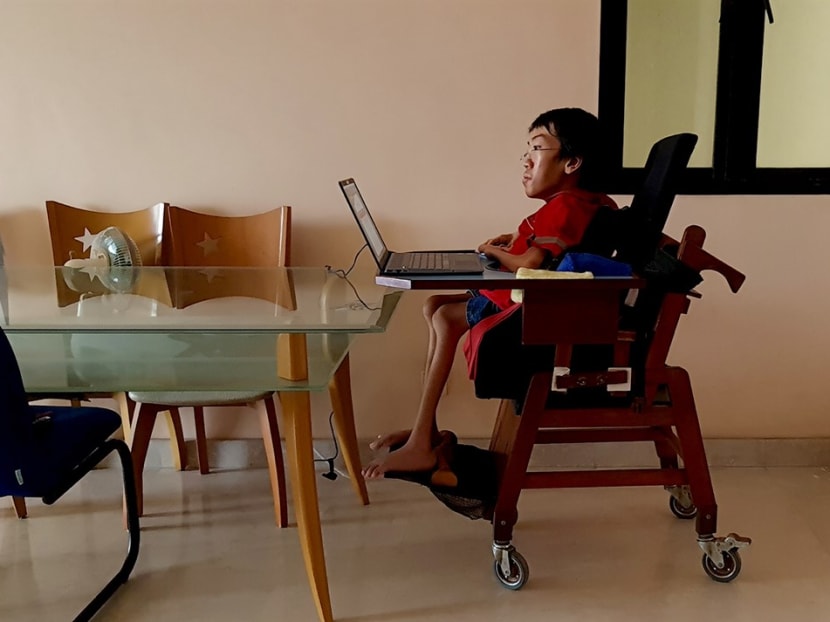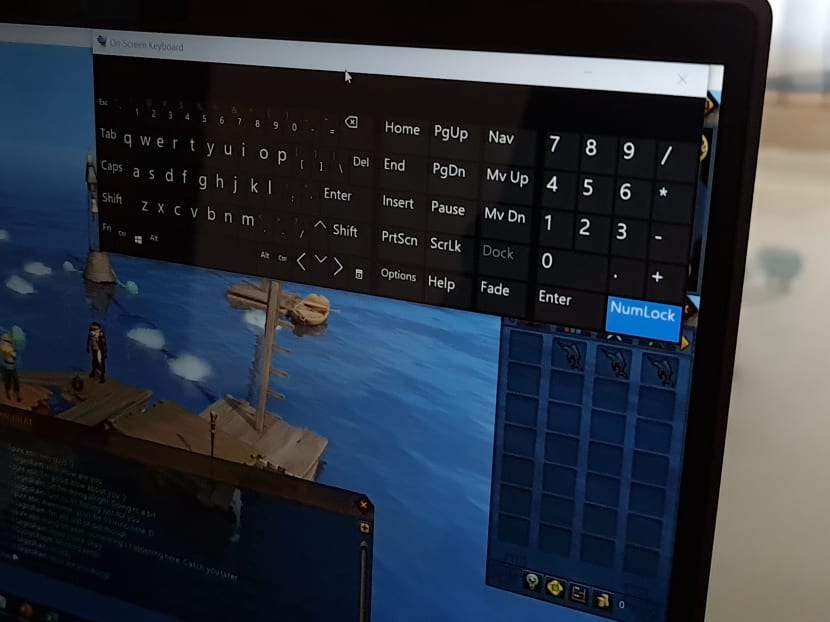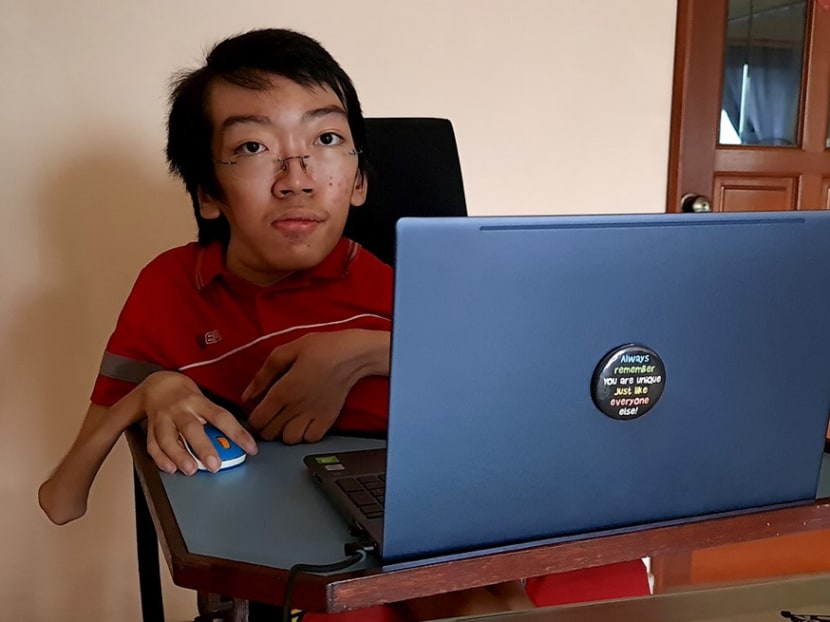Gen Y Speaks: I am disabled but tech takes me to the world and brings the world to me
Recently, I was a panellist at the Inclusive Business Forum 2020 to discuss the inclusion of disabled persons into the workforce, particularly in light of the Covid-19 crisis. What was I — a 22-year-old university student with no experience in the corporate world other than about nine months’ worth of internships — doing on the panel, telling all these high-flyers in suits how to make their businesses more inclusive?

Having spinal muscular atrophy has not stopped the author from pursuing a degree, completing internships and writing columns for TODAY, thanks to technology.
Recently, I was a panellist at the Inclusive Business Forum 2020 organised by SG Enable, an agency that helps disabled people integrate into society.
The forum brought together business leaders from various industries to discuss the inclusion of disabled persons into the workforce, particularly in light of the Covid-19 crisis.
What was I — a 22-year-old university student with no experience in the corporate world other than about nine months’ worth of internships — doing on the panel, telling all these high-flyers in suits how to make their businesses more inclusive?
I was there because the organisers of the event had read my previous disability-related commentaries in TODAY and decided that I would have interesting perspectives to share.
This is just one example of how my writing for TODAY has brought me new opportunities. And now that I think about it, none of this would have been possible without one very underrated, simple piece of assistive technology.
In fact, if you’re reading this on your computer, you probably have access to it too. I’m talking about the On-Screen Keyboard, which comes with every copy of Microsoft Windows.
This app places a virtual representation of a keyboard onto my computer screen. To type, I use a mouse to click the letters I want.
I use this app because my arms and hands lack the strength to move across my laptop’s keyboard and press the keys. This is because I have spinal muscular atrophy, a genetic life-limiting disease which causes serious and permanent physical disability.
I don’t think it’s a stretch to say that the On-Screen Keyboard is the most important piece of technology in my life right now.
It has allowed me to find success in school. It has helped me to write essays, complete examination papers and do work assignments during my two internships.
And as I begin to forge a career, the commentaries and letters in the media that I have used it to write have given me greater visibility and enhanced my personal brand.
Not only does the On-Screen Keyboard take me out into the public eye through my writing, it also brings the world to me.
Coupled with messaging apps like WhatsApp and Discord, it lets me communicate with people from other countries and cultures.
For example, I have made friends with foreigners who live in Australia, Britain and the United States through our interaction on the multiplayer online role-playing game RuneScape.
Through our chats, I have had the chance to learn about life in faraway places — locations which I will very likely never see for myself because travelling with a disability is a logistical nightmare.
I got to play armchair tourist when one of my British friends sent me a series of photographs of his dad’s village home through WhatsApp.
It was much bigger than any house I’ve seen in Singapore! It had a beautiful garden with a koi pond, a garage, and even a small jacuzzi.

Finance-related apps is another area of technology that is becoming increasingly important in my life as I become an adult and try to be as independent as I can.
Making a trip to the bank is no longer necessary for most transactions thanks to internet banking.
While internet banking brings convenience to the non-disabled, it is a relief for disabled people like me because it takes away the stress associated with leaving my home, such as having to be transported to the bank branch and accompanied by my caregiver.
Online shopping and e-wallets like PayPal are also liberating because I can browse for things I want and buy what I like without having to trouble others to do so for me.
NOT A PANACEA
But technology is never a silver bullet. For example, although the On-Screen Keyboard is useful, it has some limitations too.
First, it occupies valuable space on my screen. To make typing more comfortable, the keyboard must be of a decent size. But that also means it blocks more of my view of whatever is hidden behind it.
I often resort to dragging the keyboard around or resizing it to reveal what’s underneath. All this can get rather troublesome at times.
Another problem is that in certain situations, it doesn’t quite replace a physical keyboard.
For example, doing a “print screen” would result in the On-Screen Keyboard appearing in the screenshot too, which in most cases is undesirable.
What these limitations show is that we must resist the temptation to see technology as a magic formula.
No technology is perfect and there are always improvements that can make an existing piece of technology more helpful.
For example, what if the On-Screen Keyboard could be coded in such a way that it goes invisible when a screenshot is taken?
I believe it is technically possible — if you try to take a screenshot of a Netflix video, it will appear as a black frame but everything around it will still be visible as normal.
A similar function could be coded into the On-Screen Keyboard, except that the keyboard area becomes transparent to reveal the content underneath instead of being black.
To be fair, the app has already been greatly improved since I started using it during the Windows XP era. In those days, I literally had to click the letters individually.
Nowadays, the app is smarter and can autocomplete the words after I select a few characters and even predict what the next word is, making it much quicker and less tiring for me to type long sentences and paragraphs.
And Microsoft has a chief accessibility officer: Jenny Lay-Flurrie, who is deaf. I discovered this at the Inclusive Business Forum, where she was a fellow speaker.
Knowing that there’s someone in one of the world’s largest technology companies whose full-time job entails developing solutions that are ever more useful for people like me makes me excited and optimistic about the future.

As Covid-19 continues to disrupt societies, technology will play an increasingly important role in the lives of disabled people like me.
Many events are now being held virtually through video conferencing, which has allowed me to participate in them more readily because I don’t have to consider constraints such as venue accessibility and my energy levels on the day.
Case in point: I attended many of the online rallies during the recent General Election, as opposed to 2015 in which I didn’t attend a single physical one.
I have also never watched a getai performance during the Hungry Ghost Festival but with shows going online this year due to the pandemic, I will certainly check them out.
Certainly, the potential of technology doesn’t end there. I look forward to seeing how else technology can make my life easier, more meaningful, and more fun in the years to come.
ABOUT THE AUTHOR:
Jonathan Tiong is a fourth-year student at the National University of Singapore where he is majoring in Communications and New Media.
This piece is written in partnership with Samsung Galaxy Note20 Ultra 5G as part of a series on how technology has empowered youths in their work and play.






